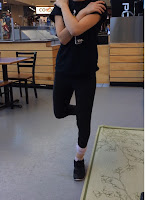A lot of athletes use single leg squat as an exercise and strength training. However, oftentimes, we see them do it wrong... knowing what the right form is is one thing and being able to do it right is another. We use single leg squat as a test to identify what the athlete is doing, being able to do or unable to do, what the athlete may need to work on, whether the athlete may be at a risk of injury, etc. We take a video of an athlete doing a single leg squat from the front and the side and put in on slow motion motion analysis app to assess it.
This is how this figure skater stood on single leg. Other than her toes/foot pointing out slightly she was comfortably standing with a good balance. Then, I asked her slowly squat down and come back up... then this is what happened (shown in the picture below).
She was having hard time balancing on her leg. Her knee collapsed. Her knee was going over her toes. It was really challenging for her.
Figure skaters spend a lot of time on ice on single leg. If this is what happens when they jump and land etc, not only will this keep them from performing well but also will lead to increased risk of injury. And if they have trouble performing single leg squat on the ground slowly, they would have much harder time doing this on ice. But the question is.... why is this happening?! It could be from a lot of different reasons and from combination of multiple contributing factors. Some of the most common contributing factors are hip muscle weakness, arch is collapsing, poor muscle strength and balance, etc. A rehabilitation specialist should be able to identify why this is happening in each athlete and fix it. Each case is different and there are additional tests we can do to find out why this faulty maneuver is happening. Or maybe this is what she or he is used to doing.
From performance and injury risk standpoint, this is a huge disadvantage because 1) figure skaters have to be able to jump without using their ankle while skating on ice 2) they have to absorb an impact that is 6-7 times of their body weight without using their ankle on one leg. And in most cases, this is something that needs to be fixed during off ice training.

